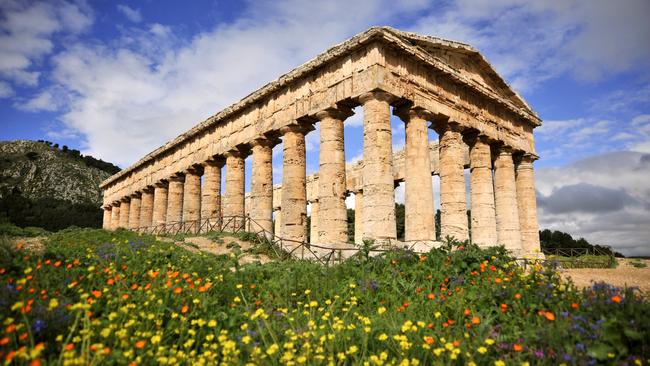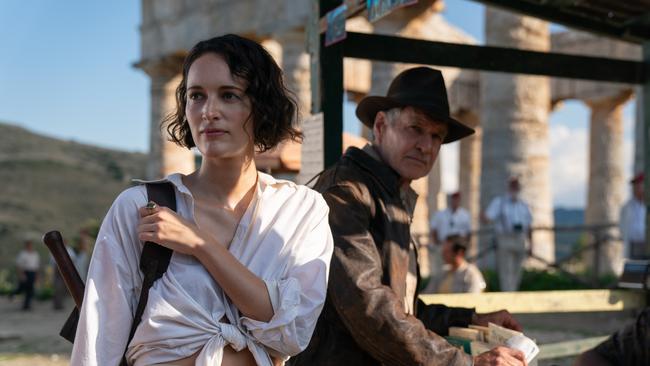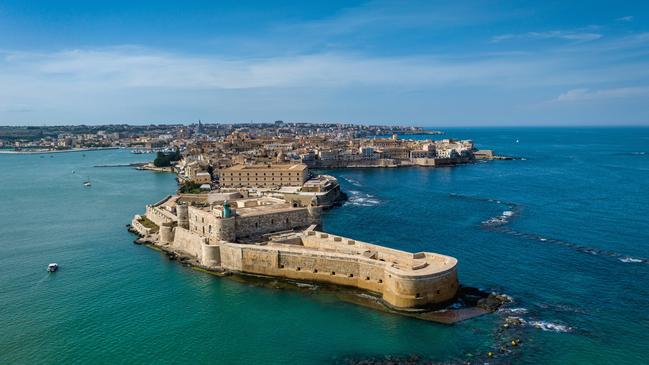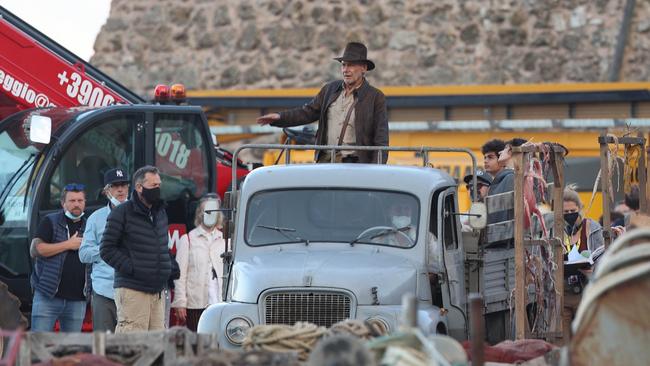Indiana Jones film showcases Sicily’s best travel attractions
It’s no wonder the latest instalment of the film franchise was shot at some of the Italian island’s ancient locations.

It is a simple question. “Did you make coffee for Harrison Ford when he was filming here?” I ask it at the Posto di Ristoro, by the Doric temple at Segesta, in western Sicily. It is a cool and windy April afternoon, and business is slow amid the cafe’s espresso spouts and glittering glass cabinets. I expect nothing more than a bored shake of the head in response but everyone’s eyes light up. Even though it has been 18 months since a scene from Indiana Jones and the Dial of Destiny – released in Australia on June 29 – have been shot here, the mention of the star’s name sparks Hollywood-sized smiles. “Coffee? We did more than make coffee,” they cry. “We fed him for weeks.”
Chef Maria Savalli catered for the cast and crew not just when they were at Segesta, but when they moved to Trapani, 30 minutes’ drive northwest. They say Ford’s favourite confection was sbriciolata, a moreish cake that’s halfway to being a crumble. After I’ve scoffed two slices with Domenico Caputo, the cafe owner, Savalli gives me a whole range of Sicilian treats to take away.
You won’t see any sbriciolata in the film, but you will see plenty of Sicily. The crew of the $450m production arrived in October 2021 and spent three weeks here, filming scenes that build towards the story’s climax. Given that the plot involves a time-travel machine invented by Archimedes (who was born in Syracuse, on the southeast coast, in 287BC), it’s no wonder the island provided several key locations.

For the ancient Greeks, Sicily was a land of milk and honey where colonists went to prosper. Of course they bickered and battled, too, but the fierce rivalry between the cities they founded gave rise to some outstanding architecture. Mighty and muscular temples were a speciality, and several survive, almost intact. If you’re looking for a full-sized evocation of those times, without a single pixel of CGI assistance, there are few better destinations. Add the allure of Sicily’s hilltop hotels and restaurants and it seems like the perfect setting for a road trip. Segesta is the obvious place to begin. It’s an easy 40-minute drive southwest from Palermo airport and gets your sightseeing off to a euphoric start. You can thank the Elymians for that. They weren’t Greek, but they found elements of the colonists’ culture irresistible all the same. Their temple dates from the troubled 5th century BC, and is a fitting symbol of it, because it was never finished. They got as far as erecting the outer circuit of pillars, as well as the architrave, frieze and triangular pediments, and that was it. They didn’t even manage to flute the columns.
READ MORE:‘I’ve been the luckiest man in the world’ | Indy goes out with a bang | Marvels of the Mediterranean | On a luxury train from Sicily to Hungary | A wildy beautiful Italian archipelago | Simply the best in luxury Italian villas
It’s easy to understand why Segesta features in Indy’s race to find Archimedes’ ingenious device. It is, in a word, ravishing. For more than a millennium the Elymians’ city spread around it, but these days there are few distractions. It makes the impression left by the temple’s towering limestone shafts, marching through the long grass like a phalanx of armoured Hoplites, even more emphatic. From here it is an hour’s drive to my first hotel, La Foresteria in Menfi, near the south coast. But I need to make a couple of Indy-inspired detours first. The northwestern end of the island is far less touristy than the east, and was therefore a much easier place in which to film. It’s also home to some gorgeous coastal landscapes.

At the harbour town of Castellammare del Golfo, a shapely headland provides the backdrop for Indy’s meeting with Renaldo, played by Antonio Banderas. Meanwhile, at the ruined tuna-packing factory, the towering cliffs of Monte Monaco frame a tumultuous battle between the Romans, the Greeks of Syracuse and some startled guests from the 21st century.
For a wannabe archaeologist such as me, however, Marsala is the real treat. Never mind that in the film its seas masquerade as the Aegean. In reality it’s a little finger of land at the western tip of Sicily that points towards north Africa. As I stand outside its archaeological museum, I can’t help wishing for a dial of destiny of my own, so I can jump back 2400 years to the days when it was held by the Carthaginians and the Mediterranean was not a frontier between two worlds but the beating heart of a busy, interconnected system of seaways.
Dinner at La Foresteria is worth the wait. The elegant hilltop hotel belongs to the Planeta family, who settled in Sicily 500 years ago. In the 1990s they diversified into wine, and after a day as sparkling as this one, a glass of the estate’s Metodo Classico Brut, made from indigenous carricante grapes grown on the slopes of Mt Etna, is the obvious aperitif. The meal that follows is just as good, the standout dish being a salad of orange and artichoke, both grown nearby.

This, then, is my template for the trip. I gorge on history (and Sicilian cakes) during the day and continue the gluttony at night over dinner. Admittedly not all the archaeology en route features in Dial of Destiny. The obvious omission is the Temple of Concordia at Agrigento, the most complete Doric temple anywhere in the Mediterranean.
For me, though, the Greek city of Selinunte is the must-see site with no Indiana Jones connections. Not only does its vast spread give a sense of how prosperous life could be here but nearby, at the Cave di Cusa, you can visit the quarries that fed its appetite for monumental architecture. Clearly they were abandoned in a hurry; so much so that two giant limestone drums, intended, no doubt, for some towering colonnade, still stand half-excavated. Nothing else you’ll see in Sicily will bring home so forcefully the exhausting labour that lay behind these grand designs.
Three hours’ drive southeast of Selinunte, near Niscemi, stands the Feudi del Pisciotto, a beautiful hilltop winery-cum-hotel, girdled by a nature reserve. It’s the obvious place to break the journey, catch your breath and check out one of the world’s most extensive Roman mosaics at Villa Romana del Casale. Then you can continue on to the seaside city of Syracuse.
Not only is Syracuse the setting for the film’s final punch-up, it is a fitting finale to my trip, for the simple reason that at its core stands Ortigia. The bustling little island at the city’s southern tip was founded as a Greek colony in the 8th century BC, and became one of the most powerful cities in the Mediterranean. These days it presents a Baroque face to the world, but look closely at its cathedral. See the Doric columns protruding from its walls? It’s built around the skeleton of the Temple of Athena in Syracuse.

Meanwhile, you’ll find the film’s fingerprints on two of the city’s most arresting sites. The first is the Ear of Dionysius, a cave with a pin-sharp acoustic in Neapolis Archaeological Park that was allegedly used as a prison. It’s into this cave that Indy climbs, accompanied by his wayward goddaughter Helena (played by Phoebe Waller-Bridge), in search of a vital link to the dial of destiny. Later, in Castello Maniace, at the southern end of the city, we meet Archimedes as he conducts an ingenious defence of his city.
When the filming was done, I hope Indy and co wandered up to the Lungomare Alfeo embankment. Here, on the western shore of Ortigia, you can gaze across the ancient harbour towards the setting sun. It’s the perfect place to raise a glass of carricante white at the end of a hard day’s filmmaking. I do just that on the last night of my tour, and it is a worthy end to such a feast.

IN THE KNOW
La Foresteria Planeta Estate is near the northwest coast of Sicily. It has 14 guestrooms and suites; from about $400 a night.
Feudi del Pisciotto is in the southwest of the island; rooms from $400 a night.
Algila Ortigia Charme Hotel is on the island of Ortigia at Syracuse; from about $390 a night.
Sean Newsom was a guest of La Foresteria, the Feudi del Pisciotto, Algila Ortigia Charme
Hotel and British tour operator Just Sicily.
THE TIMES

To join the conversation, please log in. Don't have an account? Register
Join the conversation, you are commenting as Logout